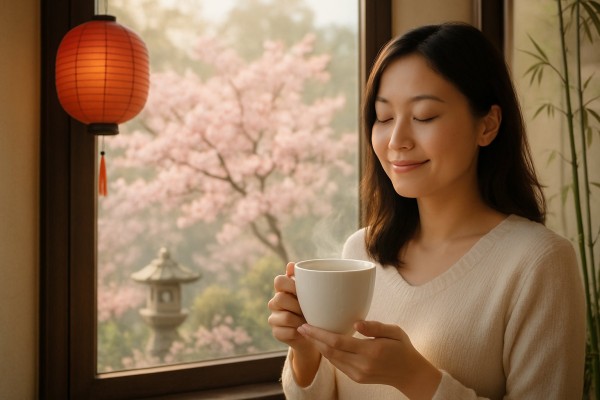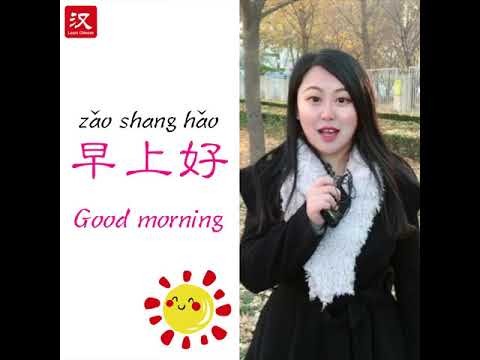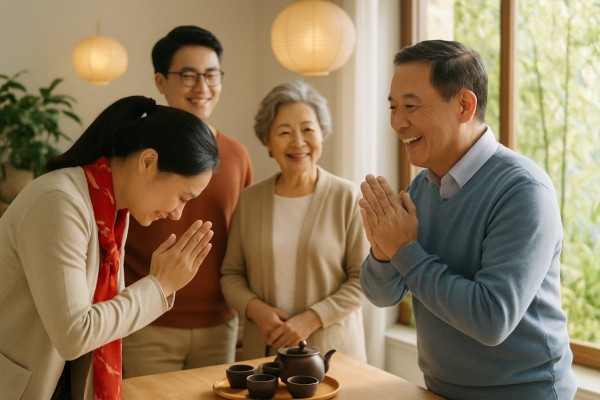How to say Good Morning in Chinese? 早上好 zǎo shàng hǎo
商务英语中的'Greeting'常用于寒暄,如'Good morning, how are you?' #生活技巧# #职场沟通技巧# #商务英语#
Learning to greet people properly in Chinese opens doors to meaningful connections and shows respect for local customs.
The most common way for how to say good morning in Chinese is “早上好” (zǎo shàng hǎo), which literally means “morning good” and works in most situations.
This greeting breaks down into “早上” (zǎo shàng) meaning “morning” and “好” (hǎo) meaning “good.”
Table of Contents
Key TakeawaysEssential Ways to Say Good Morning in ChineseStandard Morning Greeting: 早上好 (zǎo shàng hǎo)Simple and Friendly: 早 (zǎo)Formal and Cheerful: 早安 (zǎo ān)Cultural Context and Usage TipsGreeting Etiquette in Chinese CultureContextual Variations and Regional DifferencesRelated Chinese Vocabulary and ExpressionsFrequently Asked QuestionsHow to say good morning in Chinese?What is the standard Mandarin greeting for ‘good morning’?How do you wish ‘good morning’ in both Chinese and English?In what ways can you say ‘good morning’ in Cantonese?What are some common morning greetings used in China?What is the etiquette for morning greetings in Chinese culture?How might one teach beginners to say ‘good morning’ in Mandarin?More ways how to say good morning in Chinese sentences
Beyond this standard greeting, Chinese speakers use several variations depending on the time of day and social context.
Casual greetings like “早” (Zǎo) work well with friends, while more formal situations call for different approaches.
The tone and pronunciation matter a lot, since Chinese is a tonal language, change the pitch, and you might change the meaning.
Understanding when and how to use these greetings helps visitors and learners navigate Chinese culture more smoothly.
Regional variations exist across China, and proper responses show cultural awareness and respect for local customs.
Key Takeaways
The standard “早上好” (zǎo shàng hǎo) works for most morning greeting situations in Chinese Different levels of formality exist from casual “早” to more elaborate well-wishes Proper pronunciation and cultural context are essential for effective communicationEssential Ways to Say Good Morning in Chinese

Chinese speakers use three main expressions to greet people in the morning, each with different vibes.
早上好 (zǎo shàng hǎo) is the standard formal greeting. 早 (zǎo) gives you a casual option, and 早安 (zǎo ān) is polite and cheerful.
Standard Morning Greeting: 早上好 (zǎo shàng hǎo)
早上好 (zǎo shàng hǎo) stands as the most common and formal way to say good morning in Chinese.
This phrase works well in professional settings, with strangers, or when showing thanks to elders.
The greeting breaks down into two parts:
早上 (zǎo shàng) means “morning” or “early morning.” 好 (hǎo) means “good” or “well.”
ComponentPinyinMeaning早上zǎo shàngmorning好hǎogoodThis phrase translates directly to “morning good” in English word order.
Chinese speakers use this greeting from sunrise until about 10 AM.
It works perfectly for workplace interactions. Employees often greet colleagues with this phrase when arriving at the office.
Students also use it when greeting teachers or classmates.
Simple and Friendly: 早 (zǎo)
早 (zǎo) is the most casual way to say good morning in mandarin.
This single character means “early” or “morning,” and it’s a bit like saying “Morning!” in English.
Friends, family members, and peers commonly use this informal greeting.
The shortened form shows familiarity and comfort between speakers.
Young people especially favor 早 (zǎo) in text messages and casual conversations.
It’s quick to say and type, so it pops up everywhere.
早 (zǎo) works well in these situations:
Greeting close friends Family breakfast conversations Casual workplace interactions with peers Text messages and social mediaThe tone stays friendly and relaxed.
Speakers often add particles like 啊 (a) to make it 早啊 (zǎo a), which sounds even more warm and natural.
Formal and Cheerful: 早安 (zǎo ān)
早安 (zǎo ān) combines formality with warmth, making it perfect for polite morning greetings.
This phrase literally means “early peace” and gives off a wish for a peaceful morning.
The chinese language uses 早 (zǎo) for “early” or “morning.” 安 (ān) means “peace,” “safety,” or “well-being.”
Together, they create a thoughtful greeting that shows genuine care.
早安 (zǎo ān) fits all kinds of social situations. It works with both familiar and unfamiliar people.
The greeting sounds more gentle than 早上好 (zǎo shàng hǎo) but still feels formal enough.
People often use 早安 (zǎo ān) when:
Greeting neighbors politely Speaking to service workers Addressing mixed groups of people Writing formal messagesThis greeting shows up a lot in written communication, social media posts, and formal announcements.
Many Chinese speakers like it for its balance between friendliness and respect.
Cultural Context and Usage Tips

Greetings play a crucial role in Chinese culture, reflecting respect and social harmony.
Understanding proper etiquette, regional variations, and related vocabulary helps learners use morning greetings appropriately in different situations.
Greeting Etiquette in Chinese Culture
Morning greetings in Chinese culture are more than just pleasantries. They set a positive tone for interactions throughout the day.
Zǎo shang hǎo (早上好) is the go-to formal greeting.
People use this phrase in professional settings, with elders, or when meeting someone for the first time.
The greeting shows proper respect and keeps things harmonious.
Timing matters in Chinese greeting customs. Morning greetings usually go from 6 AM to 10 AM.
Trying to use an afternoon or evening greeting at the wrong time can get awkward fast.
Body language matters too. A slight bow or nod adds extra respect.
Making eye contact shows sincerity and that you’re present in the conversation.
Age and status influence greeting choices.
Younger people should greet elders first. Employees greet supervisors before starting work conversations.
This hierarchy reflects traditional Chinese values of respect and order.
Contextual Variations and Regional Differences
Different regions across China use varying morning greeting expressions.
Mandarin Chinese covers most situations, but regional dialects offer unique alternatives.
Mainland China mostly uses 早上好 (zǎoshang hǎo) in formal contexts.
The shortened 早 (zǎo) is popular among friends and family.
Taiwan commonly uses 早安 (zǎo ān) as both a formal and informal greeting.
This phrase pops up a lot in Taiwanese media and daily conversations.
Cantonese speakers in Hong Kong and Guangdong province say 早晨 (jóusàn) for morning greetings.
This one sounds pretty different from Mandarin, both in pronunciation and how people use it.
RegionFormal GreetingInformal GreetingPronunciationMainland China早上好早zǎoshang hǎo / zǎoTaiwan早安早安zǎo ānHong Kong早晨早晨jóusànProfessional settings need more formal greetings, no matter the region.
Casual environments let you use shortened versions and regional variations.
Related Chinese Vocabulary and Expressions
Chinese vocabulary for morning greetings goes way beyond just the basics.
Learning multiple expressions helps you sound much more natural and in tune with the culture.
Time-related words give your morning greetings more depth:
早晨 (zǎochén) – early morning 上午 (shàngwǔ) – morning (before noon) 清晨 (qīngchén) – dawn or early morningPolite additions make your greetings extra respectful:
您早 (nín zǎo) – a formal “good morning” with the respectful “you” 早上好,老师 (zǎoshang hǎo, lǎoshī) – good morning, teacher 辛苦了 (xīnkǔ le) – a way to acknowledge someone’s hard workCommon responses to morning greetings are pretty straightforward:
早上好 (zǎoshang hǎo) – just mirroring the greeting 你也早 (nǐ yě zǎo) – you too (informal) 早安 (zǎo ān) – another way to say good morning backWeather-related morning phrases show up a lot too:
今天天气真好 (jīntiān tiānqì zhēn hǎo) – the weather’s really nice today 早上好,阳光明媚 (zǎoshang hǎo, yángguāng míngmèi) – good morning, bright sunshine
Frequently Asked Questions
Learning proper morning greetings in Chinese isn’t just about memorizing phrases. You’ve got to pick up on cultural context and know when to use what. These questions get into pronunciation, etiquette, and how people really teach or use Mandarin morning greetings.
How to say good morning in Chinese?
To say “good morning” in Chinese, use 早上好 zǎo shàng hǎo, or just 早 zǎo.
What is the standard Mandarin greeting for ‘good morning’?
The most common Chinese phrases for good morning are 早上好 (zǎo shàng hǎo), 早安 (zǎo ān), and just 早 (zǎo).
早上好 (zǎo shàng hǎo) comes across as the most formal and standard. It literally means “good morning” and fits well in professional settings.
早安 (zǎo ān) is a neutral one you can use almost anywhere. It means “morning peace” and feels balanced—not too formal, not too casual.
早 (zǎo) is what friends or close people use. It’s super short, just “morning” and feels relaxed and friendly.
How do you wish ‘good morning’ in both Chinese and English?
Bilingual greetings mix Chinese and English all the time. People often say “Good morning” and then add a Chinese name or title.
For example, you might hear “Good morning, 老师” (lǎo shī) when talking to a teacher. It’s a nice way to show respect and keep things clear in a mixed-language group.
Sometimes, folks start with Chinese and tack on English. Like, “早上好, have a great day” it’s a blend of formal Chinese and a casual English wish.
This bilingual style pops up a lot in business. It shows cultural awareness and helps everyone understand, no matter their background.
In what ways can you say ‘good morning’ in Cantonese?
Cantonese greetings aren’t quite the same as Mandarin, pronunciation and context both shift. The main one is 早晨 (jóu sàhn), which means “good morning.”
早安 (jóu on) works too, but the tones change a bit. The meaning’s the same as in Mandarin, just with a Cantonese twist.
Different regions have their own takes. In Hong Kong, for example, people might use slightly different tones or go with more informal phrases than in mainland Cantonese-speaking places.
Morning chats in Cantonese often go beyond a simple hello. People might ask about breakfast or plans for the day as part of the greeting.
What are some common morning greetings used in China?
Daily morning greetings in Chinese cover more than just “good morning.” People often add caring questions or context to show they care.
At work, you’ll hear 早上好,同事们 (zǎo shàng hǎo, tóng shì men), which means “good morning, colleagues.” It’s a group greeting that keeps things professional.
Students usually say 早上好,老师 (zǎo shàng hǎo, lǎo shī) to greet teachers. That’s the standard in schools and educational settings.
Among friends or family, people keep it casual with 早啊 (zǎo a). It’s friendly and laid-back.
Regional dialects add their own flavor, but the main idea stays the same,people greet each other and connect.
What is the etiquette for morning greetings in Chinese culture?
Chinese greeting etiquette really values respect and social hierarchy. Age and status shape how formal you need to be with your morning hellos.
Younger folks usually greet elders first and use respectful language. That can mean adding titles like 阿姨 (ā yí) for aunts or 叔叔 (shū shu) for uncles.
At work, hierarchy matters. Employees greet supervisors before colleagues, often with formal phrases like 您早 (nín zǎo) for higher-ups.
Timing counts, too. Early and late morning greetings aren’t always the same, different words fit different times of day.
People often add a bow or nod when they say hello, especially in business. It’s a small gesture, but it really shows respect.
How might one teach beginners to say ‘good morning’ in Mandarin?
Teaching good morning greetings means focusing on pronunciation, tones, and how people actually use the phrase. Beginners do best when they start with the most common greetings before trying out variations.
Begin with 早上好 (zǎo shàng hǎo). This phrase gives clear pronunciation practice and fits most situations.
Use audio resources and repetition to practice tones. The third tone in 早 (zǎo) takes some getting used to, since its pitch changes in a way that can trip up new learners.
Try role-play scenarios to add context. Students might greet teachers, friends, or family, and can adjust how formal they sound depending on who they’re talking to.
Visual aids make character recognition easier. Flashcards with characters, pinyin, and English together help different learning styles.
Encourage regular practice in daily life. Suggest that students try out morning greetings with native speakers whenever they get the chance.
More ways how to say good morning in Chinese sentences
Chinese: 早上好,今天又是充满希望的一天!Pinyin: Zǎoshang hǎo, jīntiān yòu shì chōngmǎn xīwàng de yī tiān!
English: Good morning, today is another day full of hope! Chinese: 他每天早上都会笑着对邻居说“早上好”。
Pinyin: Tā měi tiān zǎoshang dōu huì xiàozhe duì línjū shuō “zǎoshang hǎo”.
English: Every morning he greets his neighbors with a smile and a “good morning.” Chinese: 早上好,昨晚睡得好吗?
Pinyin: Zǎoshang hǎo, zuówǎn shuì dé hǎo ma?
English: Good morning, did you sleep well last night? Chinese: 公司前台用温柔的声音向每位员工道“早上好”。
Pinyin: Gōngsī qiántái yòng wēnróu de shēngyīn xiàng měi wèi yuángōng dào “zǎoshang hǎo”.
English: The receptionist greets every employee with a gentle “good morning.” Chinese: 早上好,今天要去面包店买新鲜的培根可颂吗?
Pinyin: Zǎoshang hǎo, jīntiān yào qù miànbāo diàn mǎi xīnxiān de péigēn kěsǒng ma?
English: Good morning, shall we head to the bakery today for a fresh bacon croissant?
网址:How to say Good Morning in Chinese? 早上好 zǎo shàng hǎo https://klqsh.com/news/view/153232
相关内容
30 Different Ways to Say Hello!How to Study for (and Take!) Open Book Exams
How To Be Successful
我的高中生活优秀英语作文150词(精选16篇)
How to sign in to a Microsoft account
关于健康生活方式的英文文章
How to get help in Windows
Another Word for GOOD: List of 38 Useful Synonyms for GOOD in English
Good Time
How to Set Up Dual Monitors in Windows

